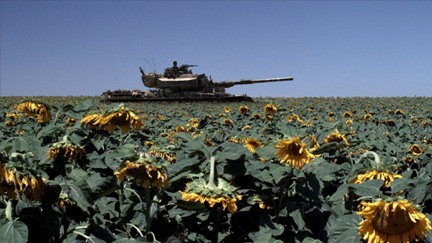

Scene from Lebanon
Lebanon, the Israeli film which won the Golden Lion at Venice opened in Israel this month, and was one of the 355 films screened at the Pusan International Film Festival in South Korea this past week.
Samuel “Shmulik†Maoz’s award winning had its U.S. premiere at the New York Film Festival and was much talked about at the Toronto festival as well.
Maoz’s (although some pronounce his name Moaz, and I keep thinking of the name of the chain of felafel shops in New York and Europe) film is set nearly entirely inside an Israeli Army tank in the Summer of 1982, on the first day of the war in Lebanon – a war that has been the focus of at least two other recent Israeli films, including “Waltz With Bashir.†Actually, “Lebanon†shares some of the same actors with one of the Israeli war films, “Beaufort.“
Asked why Lebanon has been the subject of recent films, Maoz suggested that it is just the time that the generation that served in 1982 is reflecting on the events they survived. He added that the 1982 war, contrasted with prior wars, did not have clear rules, and was a war in which the opposing forces wore jeans instead of uniforms and blended into the civilian population.
The film opens in silence, in a field of twisting sunflowers. We meet four young members of a tank crew, in cramped, hot, perspiring quarters; they are supposedly men of steel inside a tank of iron.
As they cross into Lebanon from the northern border of Israel, the audience realizes that it is in for a very loud, noisy, dirty, grimy, drippy, bumpy ride in the claustrophobic, metal tank. Owen Gleiberman, a critic for “Entertainment Weekly,” after seeing the film in Toronto, likened watching it to seeing “Das Boot,†the German submarine classic, inside a subway urinal. (This is probably due to the constant needs of the soldiers to relieve themselves during their stay inside the tank, and the pools of sweat and oil and other liquids that accumulate on the floor of the tank.)
I saw the film without any prior knowledge of its scenes, and I will keep you in the dark as well, since this is the best way to experience the film. But I will tell you that Maoz has created an experiential film that succeeds in making you feel the physical confinement and heat and bewilderment of the crew. The crew and the audience lack any power to control the events and lack a perspective and knowledge in this fog of war. Who can you trust inside your tank and outside of it? Will the gunner’s hesitations or the crew’s orders spell death or life? The outside world is visible only through the prism of the lens of the periscope gun sight, which is controlled by a gunner named Shmulik, the Israeli namesake of the director. Shmulik represents the emotional experiences of the film’s director, who in real life served in a tank crew in Beirut.
To prepare the actors for their roles, Maoz placed each of them alone in a dark, metal, hot container for several hours, and hit the container with metal rods to simulate gunfire. After a few hours of that, he said, the actors understood how they needed to act in a tank. No additional words were required.
Asked about how he found the tank for the film’s shoot, Maoz replied that they were unable to get an Israeli tank from the IDF (especially due to some of the scenes in the script), but since there are many “empty tanks†scattered throughout Israel, his Art Department was able to “find†one in the Golan and use it for some shots.
Having the film shot solely inside a “tank set†also allowed the production to severely reduce its expenses. The actors also worked on the crew when not in the shots. It was shot in under a month, and, believe it or not, it was shot in the Tel Aviv shuk, Beit Jubrin, and in an empty warehouse near Rehov Yigal Alon.
Asked about the meaning of the opening shot among sunflowers, Maoz replied that he would leave that for the audience to decide for themselves. As for the ultimate meaning of the film, Maoz replied with the tale from the film’s premiere at the Venice Film Festival. He won the Golden Lion, while an Iranian director won the Silver Lion. For hours they were photographed together with their lions. At an after-party, someone came up to them to show them an online blog that had already posted the picture of the winning Israeli and Iranian directors standing together. The caption read, “Peace is Possible.†Maoz said, “This was the goal of the film.â€






I always enjoy your posts, Larry. Thanks.